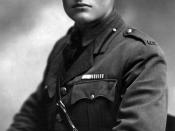Ernest Hemingway's novella "The Old Man and the Sea" is considered to be his last, and often his greatest, literary work. The short novel, which is comprised of less than one hundred pages, recounts the trials of an elderly Cuban fisherman who is thrust into an exhausting life-or-death struggle of wills when he hooks an unmatchable marlin. When questioned about the presence of symbols in the novel, Hemingway maintained that any symbolism present was unintended. Despite the comparably short length of the story and Hemingway's claims, the pages are packed full of symbols and themes open to interpretation. From the beginning sentence to the very end, Hemingway employs a very basic, honest approach to storytelling using efficiently minimalist language to deliver a complex and engaging tale of pride, struggle, defeat and resolution.
One ever-present symbol in Hemingway's novella is the sea. It represents the vast, limitless stage of life and the unpredictability of the world that surrounds it.
Even more so, the sea represents Santiago's eternal friend and enemy. On more than one occasion it is suggested that, to Santiago, the sea is characteristically female; to him, la mar was "something that gave or withheld great favours, and if she did wild or wicked things it was because she could not help them. The moon affects her as it does a woman, he thought." (28) The man is at ease with the sea and her unpredictability even though he is at her will, for she provides the opportunities that rule his existence and livelihood and he understands that. The same is true if you view the sea and the novel itself as parallels for life; those who are living have no choice but to weather the tides and storms of time, and can only learn to accept that...


